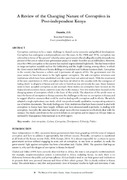| dc.description.abstract | Corruption continues to be a major challenge to Kenya’s socio-economic and political development. Corruption has undergone a metamorphosis over the years. In the 1960s and 1970s, corruption was referred to in terms of “ten percent” whereby senior government officials allegedly used to demand a ten percent of the cost or value of any government project or tender from the successful bidders. However, since the 1990s corruption in the country has reached unprecedented high levels. This has been evident in mega corruption scandals such as the Goldenberg and the Anglo-Leasing, among others, in which the Government lost billions of Kenya shillings in fraudulent and fictitious business deals. Corruption in the country has become a culture and it permeates all aspects of life. The government over the years seems to have lost steam in the fight against corruption. The anti-corruption structures and institutions which have been established over the years have not achieved much. With the enactment of the new constitution in 2010, corruption has been devolved to the counties with the emergence of ‘eating chiefs’ in all parts of Kenya and not only in Nairobi as was previously the case. Many Kenyans seem to have accepted corruption as fait accompli. Most studies on corruption have focused on the financial and economic losses countries incur due to the menace. Very few studies have focused on the changing nature of corruption which is the focus of this article. The objectives of the article were: to trace the forms of corruption in Kenya; examine the challenges in the war on corruption in Kenya; and to suggest effective measures that could be used in dealing with corruption and its effects. The article adopted a single exploratory case study, which was predominantly qualitative, incorporating extensive use of written documents. The study findings are: First, institutions that have been created to deal with corruption in Kenya have been largely stillborn and have demonstrated ineptitudes in dealing with corruption. Secondly, the state has failed to adopt more effective measures to effectively deal with the menace. The study contributes to the current debate on corruption and its impact on African States as outlined by Transparency International in its 2016 report. | en_US |
